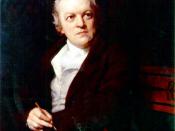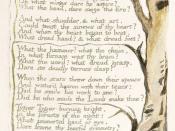Are things always what they seem? Is our first impression always right? In "The Tiger" William Blake uses tone, theme, and rhyme to make the point that there are two sides to everything.
If you came face-to-face with a tiger you would probably be afraid. But if you put your fear aside and took a closer look you would probably notice how beautiful the tiger is. Blake uses particular words to make the tone of fear and awe in this poem. Almost like you were looking at the tiger yourself. He uses the word "dare" four times. I think this is because dare means "to have the courage needed to do something", suggesting overcoming fear with courage. He describes the tiger as having "fearful symmetry." Symmetry means "harmony or beauty of form that results from balanced proportions." Blake is then describing the tiger as fearful and beautiful.
When he says "What dread grasp dare its deadly terror clasp?" he inspires fear by using the words "dare", "deadly", "terror", and "dread." Together all these thinks make the poem come to life as you read it, inspiring fear and awe.
The poem seems to pull you into its grasp as your read. This is because of the rhyme in this poem. It is an ABAB pattern. In lines 1 and 2 "bright" and "night" rhyme. Then in lines 5 and 6 "skies" and "eyes" rhyme. This pattern also made me think of the pit-pat of the paws of a tiger walking. Each line follows neatly into the following line.
"What immortal hand or eye could frame thy fearful symmetry?" Blake states the theme here. He is asking what godly hand made the tiger's beautiful symmetry. I think that he says, "could" to imply work or a...


